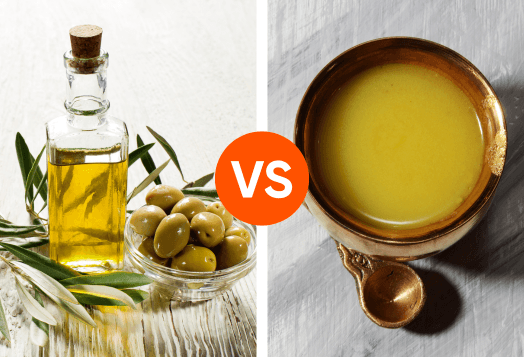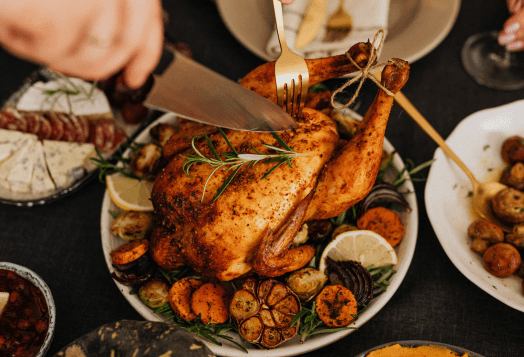Navratri is a festival of devotion, discipline, and vibrant celebration, filled with rituals, prayers, and a shift toward mindful living. Many observe fasts during this time, embracing a lighter, purer diet. But figuring out what we can eat in Navratri fast can get confusing. This guide breaks down essential Navratri food choices, recipes, and expert tips to help you fast the healthy way.
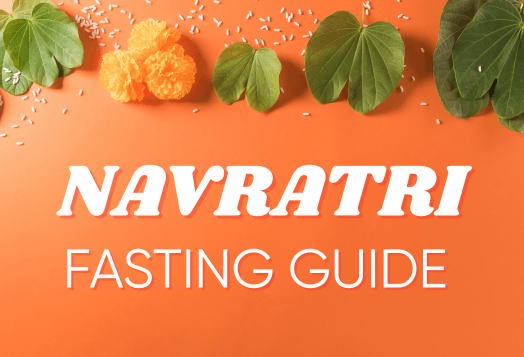
What is Navratri and Why Do We Fast?
Navratri literally means "nine nights," and it’s celebrated twice a year to honour the nine forms of Goddess Durga. Along with spiritual practices like prayer and meditation, fasting is considered one of the most important rituals during this period.
The roots of fasting go deep. According to Ayurveda, this is the ideal time for the body to detox and reset, especially during seasonal transitions, much like the principles behind intermittent fasting for women. And that’s why the benefits of the Navratri fast aren’t just spiritual, they’re physical and emotional too.
Fasting can help reduce inflammation, improve digestion, and promote mental clarity. By cutting out processed foods and sticking to a cleaner Navratri diet, many people feel lighter and more focused.
Navratri Fasting Rules You Should Know
If you’re observing a fast, it's essential to know what’s permitted and what’s not. The below given Navratri fasting food list is based on a sattvic diet, meaning foods that are light, natural, and calming to the mind. Here’s what’s typically allowed:
Grains like samak rice, rajgira, and kuttu (buckwheat) flour
Root vegetables like potatoes, sweet potatoes, and colocasia
Fruits, nuts, and seeds
Dairy products like milk, curd, and paneer
Sendha namak (rock salt) instead of regular table salt
Mild spices like cumin, ginger, and black pepper
And what should be avoided?
Regular grains (wheat, rice, corn), lentils, and pulses
Onion and garlic (considered tamasic)
Iodised salt
Alcohol, non-veg, and processed snacks
What Can We Eat in Navratri Fast?
This is the most searched question, and for good reason. What can we eat in Navratri fast without compromising our health or energy levels? Here’s a handy table that breaks down the essential Navratri food groups and their fasting-safe options:
Category | Navratri Food Options |
Grains & Flours | Samak rice, buckwheat (kuttu), amaranth (rajgira) |
Vegetables | Potato, sweet potato, colocasia, pumpkin |
Fruits | Banana, apple, papaya, pomegranate |
Dairy | Milk, curd, paneer |
Nuts & Seeds | Almonds, walnuts, peanuts, makhana |
Seasonings | Sendha namak, cumin, ginger, black pepper |
Beverages | Coconut water, lemon water, buttermilk |
These ingredients form the base of a healthy Navratri diet. They’re light, wholesome, and energising. Plus, they offer enough variety to avoid boredom throughout the nine days.
What Not to Eat in Navratri
Just like there’s a list of vrat-friendly ingredients, there’s a clear Navratri fasting food list of what you should avoid. These foods are either hard to digest, overly processed, or spiritually inharmonious:
Grains like wheat, rice, oats, and barley
Onion and garlic
Table salt (swap with sendha namak)
Processed foods, sauces, packaged chips, and snacks
Non-veg and alcohol
The idea is to keep meals simple and sattvic to enhance both digestion and spiritual practice.
Simple Navratri Recipes You’ll Love
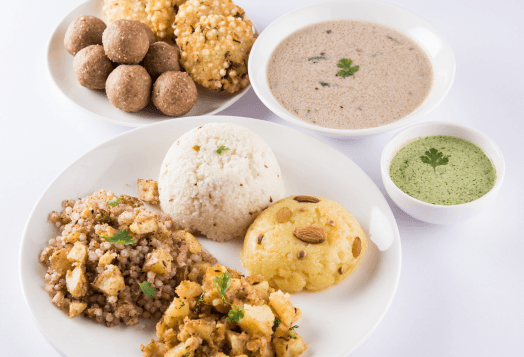
Don’t worry, fasting doesn’t mean flavourless. With the right Navratri food staples, you can create meals that are hearty, delicious, and 100% vrat-friendly.
1. Sabudana Khichdi
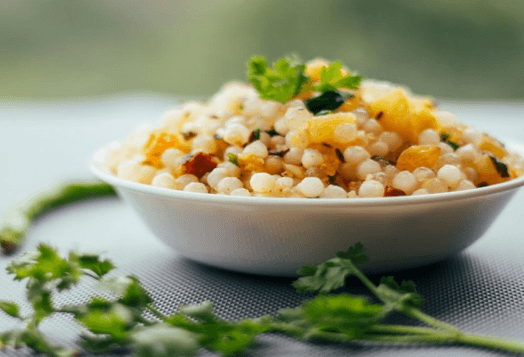
Soak 1 cup of sabudana overnight until soft and non-sticky. In a pan, heat 1–2 tablespoons of ghee and temper with cumin seeds, chopped green chillies, and boiled potato cubes. Add the soaked sabudana and cook on a low flame, stirring gently. Finish with a generous sprinkle of roasted, crushed peanuts and a dash of sendha namak for flavour.
2. Aloo Ki Sabzi
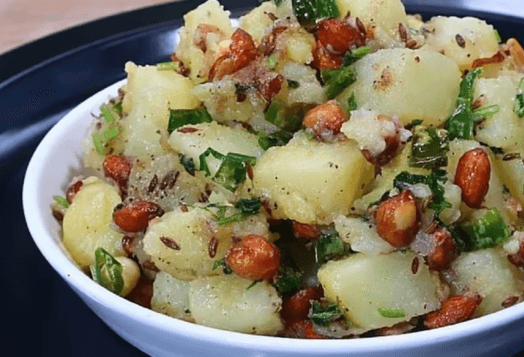
Boil and peel 3–4 medium potatoes, then roughly cube them. In a kadhai, heat ghee and add cumin seeds, chopped green chillies, and grated ginger. Toss in the potatoes with sendha namak and cook for 5–7 minutes until lightly crispy. Garnish with fresh coriander and a squeeze of lemon juice for a zesty finish.
3. Singhara Cheela
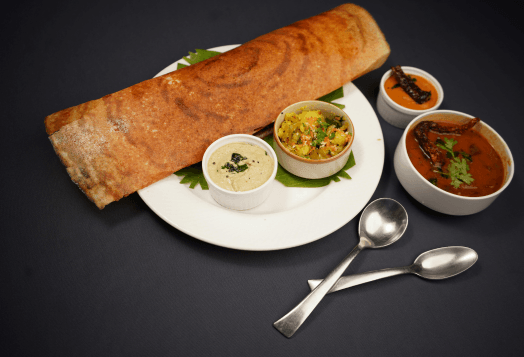
In a bowl, mix 1 cup singhara atta with ½ cup curd, sendha namak, chopped green chillies, and cumin seeds to form a smooth batter. Rest it for 10 minutes. Heat a non-stick pan and spread a ladle of the batter like a dosa, cooking each side with a little ghee until golden brown. Serve hot with mint chutney or curd.
4. Samak Rice Pulao
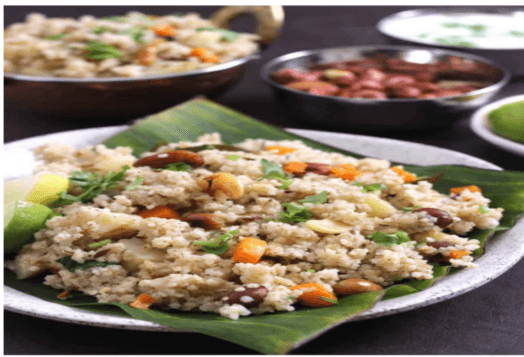
Rinse and soak 1 cup of samak rice for 15–20 minutes. In a pan, heat ghee and sauté cumin seeds, grated ginger, diced pumpkin (or carrots), and green chillies. Add the drained rice, 2 cups of water, and sendha namak, then cook until the water is absorbed and the rice is fluffy. Garnish with chopped coriander and serve warm.
5. Makhana Kheer
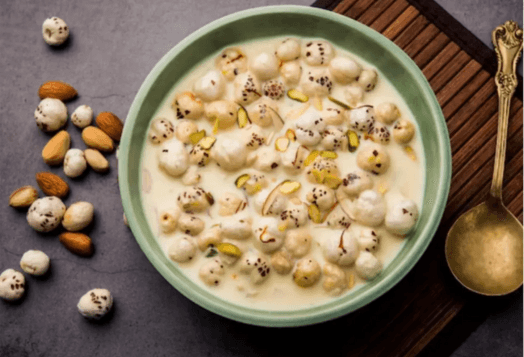
Dry roast 1 cup makhana in a bit of ghee until crisp, then crush lightly. In a saucepan, bring 500 ml of milk to a boil and add the makhana, cooking on a low flame until soft. Stir in jaggery (or a little sugar), cardamom powder, and chopped almonds or cashews. Simmer until it thickens to a creamy consistency and serve warm or chilled.
Healthy Fasting Tips to Stay Energised
Following a Navratri diet can be energising if done right. Here are some quick tips:
Don’t skip meals. Break your fast with fruit or curd, and eat every few hours.
Stay hydrated with coconut water, lemon water, and herbal teas.
Balance your plate—don’t just rely on potatoes. Add paneer, nuts, and samak for variety.
Avoid deep-fried vrat snacks. Choose baked, roasted, or steamed options when possible.
Nutritional Benefits of Navratri Fast
Now let’s talk about the real deal—the benefits of Navratri fast. Fasting, when approached mindfully, can offer major wellness advantages:
Cleanses the digestive system by removing toxins
Promotes discipline and reduces dependence on stimulants like sugar or caffeine
Improves metabolism by giving the gut a break
Enhances mental clarity and emotional stability
It’s no wonder that many people feel more focused and refreshed after the nine days. The benefits of the Navratri fast are both immediate and long-term.
Common Mistakes to Avoid
Even with the best intentions, it’s easy to go wrong. Many people overeat fried snacks, thinking they’re vrat-friendly. Others skip meals, only to feel dizzy or irritable.
Another common mistake is consuming only starchy foods without any protein or fibre. That leads to energy crashes, not spiritual clarity. Hydration is also key; drink more fluids than usual to support detox.
Fast Mindfully, Eat Joyfully
Fasting during Navratri isn’t just about what you skip—it’s about what you consciously include. The right Navratri food nourishes your body, uplifts your energy, and supports your spiritual journey. With a well-balanced Navratri diet plan for 9 days crafted by nutritionists and dietitians, you’ll feel lighter, calmer, and more connected.
Whether you’re making sabudana khichdi at sunrise or savouring makhana kheer after sundown, let every bite be meaningful.


